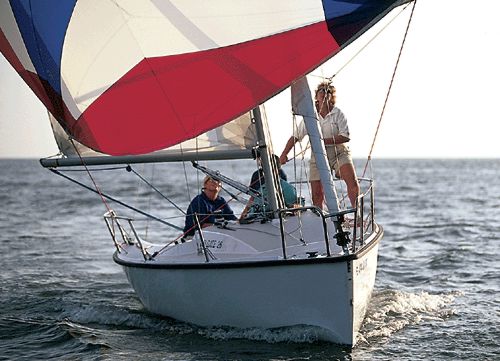The Spinnaker - Terminology
Part 1 in the 7-Part Spinnaker Series
 There are two main types of spinnakers: symmetrical and asymmetrical. The symmetrical spinnaker is the more traditional version and uses a pole. The tack (on symmetrical spinnakers) is attached to the pole. The advantage here is the pole which can be trimmed aft to allow the sail to remain full and powered while sailing further off the wind than the asymmetrical sail allows. The asymmetrical spinnaker is now used on some contemporary racing sailboats. Its advantage is the simplicity of the rig without the pole. Our discussion of spinnakers will focus on the symmetrical spinnaker and pole rig.
There are two main types of spinnakers: symmetrical and asymmetrical. The symmetrical spinnaker is the more traditional version and uses a pole. The tack (on symmetrical spinnakers) is attached to the pole. The advantage here is the pole which can be trimmed aft to allow the sail to remain full and powered while sailing further off the wind than the asymmetrical sail allows. The asymmetrical spinnaker is now used on some contemporary racing sailboats. Its advantage is the simplicity of the rig without the pole. Our discussion of spinnakers will focus on the symmetrical spinnaker and pole rig.
The spinnaker is a triangular sail, with a head, tack, and clew. The tack of the spinnaker is in a fixed position-at the end of the spinnaker pole. As with other sails, the edge of the spinnaker from the tack to the head is the "luff," from the clew to the head is the "leach," and from the clew to the tack is the "foot." When the spinnaker is not in use, the two edges are identical, so we call each a leech (and each corner a clew) until the sail is set and the luff is established by whichever corner (now called the tack) is attached to the spinnaker pole.
The spinnaker is hoisted by the spinnaker halyard, and the tack is held in place by the pole, which is always set to windward; i.e., on the opposite side of the boat from the main boom. Actually, the jaws of the pole fitting snap over the line attached to the tack of the spinnaker. This line is the "afterguy" or, more commonly, the "guy." The guy leads aft outside of everything to a turning block on the rail and thence to a winch. The free corner (now the clew) of the spinnaker is attached to a sheet that leads aft to turning block and winch on the other side of the boat. When you jibe the spinnaker, the tack becomes the "new" clew and the "old" clew becomes the "new" tack at the pole.
Two lines hold the pole in position: the topping lift, which keeps it from falling when the spinnaker isn't full of wind, and the foreguy (also called the downhaul), which keeps the pole from "skying" (pointing up on the air) when the spinnaker is full, and from coming aft when the guy is trimmed. On large cruising and racing boats, two additional lines-the lazy guy and the lazy sheet-are sometimes added to facilitate jibing the spinnaker.
Also essential in spinnaker control is the reaching strut, as shown in diagram. This is a short pole set perpendicular to the mast and through which the spinnaker guy is led. It is used when close-reaching (when the spinnaker pole is near the headstay). Without the strut, the guy rests against the shrouds and when you try to square the pole (by pulling it aft), there is so little angle outboard that it takes a tremendous amount of winching of the guy to pull the pole aft. This results in so much compression on the pole that either the pole or the guy may break.
I thought about this problem and in the fall of 1957 came up with the "reaching strut" solution. At that time no such "outrigger" was permitted under the racing rules. As soon as it became legal, however, struts flourished. Over the years they have become more and more sophisticated, to the extent that some maxis have a hydraulic telescoping strut to handle the strain. On large yachts, when the pole is well forward and the guy is lying against the shrouds, it takes 10 men and a boy to push the strut out against the heavily loaded guy and hook it on the mast. If you find yourself in this position, it helps to take the strain temporarily on the lazy sheet, which will permit enough slack in the guy so that it can easily be slipped into the fitting on the end of the reaching strut.
Happy sailing!
Reprinted from "Steve Colgate on Sailing."
By Steve Colgate, Published by W.W. Norton & Co.
Steve Colgate is the founder of Colgate Sailing Schools, with locations in Tortola BVI, Captiva Island FL, Duck Key FL, St. Petersburg FL, Chelsea Piers NY, Liberty Landing NJ and Newport RI.
Offshore Sailing Schools
16731 McGregor Blvd.
Fort Myers, Florida 33908
1-888-454-8002
239-454-1700
Fax: 239-454-1191
e-mail: sail@offshore-sailing.com
www.offshoresailing.com












